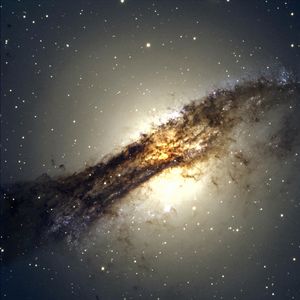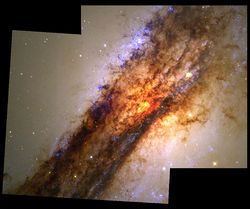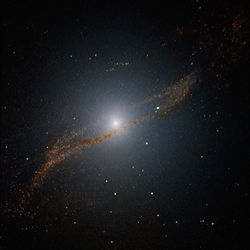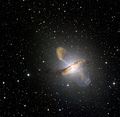Centaurus A
| Centaurus A | |
|---|---|
 Centaurus A (NGC 5128) |
|
| Observation data (J2000 epoch) | |
| Constellation | Centaurus |
| Right ascension | 13h 25m 27.6s[1] |
| Declination | -43° 01′ 09″[1] |
| Redshift | 547 ± 5 km/s[1] |
| Distance | 13.7 ± 0.9 Mly (4.2 ± 0.3 Mpc)[2] ~12 Mly (3.679 Mpc)[3] |
| Type | S0 pec[1] |
| Apparent dimensions (V) | 25′.7 × 20′.0[1] |
| Apparent magnitude (V) | 6.84[4][5] |
| Notable features | Unusual dust lane |
| Other designations | |
| NGC 5128,[1] Arp 153,[1] PGC 46957[1], 4U 1322-42 [6] | |
| See also: Galaxy, List of galaxies | |
Centaurus A (also known as NGC 5128) is a lenticular galaxy about 11 million light-years away[7] in the constellation Centaurus. It is one of the closest radio galaxies to Earth, so its active galactic nucleus has been extensively studied by professional astronomers.[8] The galaxy is also the fifth brightest in the sky,[8] making it an ideal amateur astronomy target,[9] although the galaxy is only visible from low northern latitudes and the southern hemisphere.
A relativistic jet which extracts energy from the vicinity of what is believed to be a supermassive black hole at the center of the galaxy is responsible for emissions in the X-ray and radio wavelengths. By taking radio observations of the jet separated by a decade, astronomers have determined that the inner parts of the jet are moving at about one half of the speed of light. X-rays are produced farther out as the jet collides with surrounding gases resulting in the creation of highly energetic particles.
As observed in other starburst galaxies, a collision is responsible for the intense burst of star formation. Using the Spitzer Space Telescope scientists confirm that Centaurus A is going through a galaxy collision by devouring a spiral galaxy.
Contents |
Morphology


Centaurus A may be described as having a peculiar morphology. As seen from Earth, the galaxy looks like a lenticular or elliptical galaxy with a superimposed dust lane.[10] The peculiarity of this galaxy was first identified in 1847 by John Herschel, and the galaxy was included in the Atlas of Peculiar Galaxies (published in 1966) as one of the best examples of a "disturbed" galaxy with dust absorption.[11] The galaxy's strange morphology is generally recognized as the result of a merger between two smaller galaxies.[12]
The bulge of this galaxy is comprised mainly of evolved red stars.[10] The dusty disk, however, has been the site of more recent star formation;[8] over 100 star formation regions have been identified in the disk.[13]
Supernovae
One supernova has been detected in Centaurus A.[14] The supernova, named SN 1986G, was discovered within the dark dust lane of the galaxy by R. Evans in 1986.[15] It was later identified as a type Ia supernova,[16] which forms when a white dwarf's mass grows large enough to ignite carbon fusion in its center, touching off a runaway thermonuclear reaction, as may happen when a white dwarf in a binary star system strips gas away from the other star. SN 1986G was used to demonstrate that the spectra of type Ia supernovae are not all identical, and that type Ia supernovae may differ in the way that they change in brightness over time.[16]
Nearby galaxies and galaxy group information
Centaurus A is at the center of one of two subgroups within the Centaurus A/M83 Group, a nearby group of galaxies.[17] Messier 83 (the Southern Pinwheel Galaxy) is at the center of the other subgroup. These two groups are sometimes identified as one group[18][19] and sometimes identified as two groups.[20] However, the galaxies around Centaurus A and the galaxies around M83 are physically close to each other, and both subgroups appear not to be moving relative to each other.[21] The Centaurus A/M83 Group is located in the Virgo Supercluster.
Amateur astronomy information
Centaurus A is located approximately 4° north of Omega Centauri (a globular cluster visible with the naked eye).[9] Because the galaxy has a high surface brightness and relatively large angular size, it is an ideal target for amateur astronomy observations. The bright central bulge and dark dust lane are visible even in finderscopes and large binoculars,[9] and additional structure may be seen in larger telescopes.[9] Centaurus A has been spotted with the naked eye by Stephen James O'Meara.[22]
Other images
 The heavily-obscured inner (barred?) spiral disk at 24 μm as shown by the Spitzer IR telescope |
 Chandra X-Ray view of Cen A in X Rays showing one relativistic jet from the central black hole |
 Centaurus A in submillimeter light by APEX showing the giant radio lobes, powered by the jets. Credit ESO |
 A composite image showing the size of the radio glow from the galaxy Centaurus A in comparison to the full Moon. The white dots in the sky represent not stars but background radio sources — galaxies like Centaurus A in the distant universe. The foreground antennas are of CSIRO's Australia Telescope Compact Array, which gathered the data for the Centaurus A image. |
See also
- Messier 87 - a giant elliptical galaxy that is also a strong radio source
- NGC 1316 - a similar lenticular galaxy that is also a strong radio source
External links
- SEDS: Peculiar Galaxy NGC 5128
- ESA/Hubble images of Centaurus A
- NASA's APOD: The Galaxy Within Centaurus A (3/4/06)
- NASA's APOD: X-Rays from an Active Galaxy (7/5/03)
- High-resolution image of Centaurus A showing the discrete elements of galactic core
- Centaurus A at UniverseToday.com
- NGC5128 Centaurus A
- Centaurus A on WikiSky: DSS2, SDSS, GALEX, IRAS, Hydrogen α, X-Ray, Astrophoto, Sky Map, Articles and images
References
- STScI. Hubble Provides Multiple Views of How to Feed a Black Hole. Press release: Space Telescope Science Institute. March 14, 1998.
- Chandra X-Ray Observatory Photo Album Centaurus A Jet
- ↑ 1.0 1.1 1.2 1.3 1.4 1.5 1.6 1.7 "NASA/IPAC Extragalactic Database". Results for Centaurus A. http://nedwww.ipac.caltech.edu/. Retrieved 2006-12-06.
- ↑ J. L. Tonry, A. Dressler, J. P. Blakeslee, E. A. Ajhar, A. B. Fletcher, G. A. Luppino, M. R. Metzger, C. B. Moore (2001). "The SBF Survey of Galaxy Distances. IV. SBF Magnitudes, Colors, and Distances". Astrophysical Journal 546 (2): 681–693. doi:10.1086/318301. http://adsabs.harvard.edu/abs/2001ApJ...546..681T.
- ↑ "Distance Results for NGC 5128". NASA/IPAC Extragalactic Database. http://nedwww.ipac.caltech.edu/cgi-bin/nDistance?name=NGC+5128. Retrieved 2010-04-26.
- ↑ "SIMBAD-A". SIMBAD Astronomical Database. http://simbad.u-strasbg.fr/simbad/sim-id?Ident=Centaurus+A. Retrieved 2009-11-29.
- ↑ Armando, Gil de Paz; Boissier; Madore; Seibert; Boselli; et al. (2007). "The GALEX Ultraviolet Atlas of Nearby Galaxies". Astrophysical Journal (ApJS) 173: 185–255. doi:10.1086/516636. http://arxiv.org/abs/astro-ph/0606440. Retrieved 2009-11-29.
- ↑ 4U catalog browse version.
- ↑ L. Ferrarese et al (2007). "The Discovery of Cepheids and a Distance to NGC 5128". Astrophysical Journal 654: 186–218. doi:10.1086/506612. http://adsabs.harvard.edu/abs/2007ApJ...654..186F.
- ↑ 8.0 8.1 8.2 F. P. Israel (1998). "Centaurus A - NGC 5128". Astronomy and Astrophysics Review 8: 237–278. doi:10.1007/s001590050011. http://adsabs.harvard.edu/abs/1998A&ARv...8..237I.
- ↑ 9.0 9.1 9.2 9.3 D. J. Eicher (1988). The Universe from Your Backyard. Cambridge: Cambridge University Press. ISBN 0-521-36299-7.
- ↑ 10.0 10.1 A. Sandage, J. Bedke (1994). Carnegie Atlas of Galaxies. Washington, D.C.: Carnegie Institution of Washington. ISBN 0-87279-667-1.
- ↑ H. Arp (1966). "Atlas of Peculiar Galaxies". Astrophysical Journal Supplement 14: 1–20. doi:10.1086/190147. http://adsabs.harvard.edu/abs/1966ApJS...14....1A.
- ↑ W. Baade, R. Minkowski (1954). "On the Identification of Radio Sources". Astrophysical Journal 119: 215–231. doi:10.1086/145813. http://adsabs.harvard.edu/abs/1954ApJ...119..215B.
- ↑ P. W. Hodge, R. C. Kennicutt Jr. (1982). "An atlas of H II regions in 125 galaxies". Astrophysical Journal 88: 296–328. doi:10.1086/113318. http://adsabs.harvard.edu/abs/1983AJ.....88..296H.
- ↑ "NASA/IPAC Extragalactic Database". Results for extended name search on Centaurus A. http://nedwww.ipac.caltech.edu/. Retrieved 2007-03-07.
- ↑ R. Evans, R. H. McNaught, C. Humphries (1986). "Supernova 1986G in NGC 5128". IAU Circular 4208. http://adsabs.harvard.edu/abs/1986IAUC.4208....1E.
- ↑ 16.0 16.1 M. M. Phillips, A. C. Phillips, S. R. Heathcote, V. M. Blanco, D. Geisler, D. Hamilton, N. B. Suntzeff, F. J. Jablonski, J. E. Steiner, A. P. Cowley, P. Schmidtke, S. Wyckoff, J. B. Hutchings, J. Tonry, M. A. Strauss, J. R. Thorstensen, W. Honey, J. Maza, M. T. Ruiz, A. U. Landolt, A. Uomoto, R. M. Rich, J. E. Grindlay, H. Cohn, H. A. Smith, J. H. Lutz, R. J. Lavery, A. Saha (1987). "The type 1a supernova 1986G in NGC 5128 - Optical photometry and spectra". Publications of the Astronomical Society of the Pacific 99: 592–605. doi:10.1086/132020. http://adsabs.harvard.edu/abs/1987PASP...99..592P.
- ↑ I. D. Karachentsev, M. E. Sharina, A. E. Dolphin, E. K. Grebel, D. Geisler, P. Guhathakurta, P. W. Hodge, V. E. Karachetseva, A. Sarajedini, P. Seitzer (2002). "New distances to galaxies in the Centaurus A group". Astronomy and Astrophysics 385: 21–31. doi:10.1051/0004-6361:20020042. http://adsabs.harvard.edu/abs/2002A&A...385...21K.
- ↑ R. B. Tully (1988). Nearby Galaxies Catalog. Cambridge: Cambridge University Press. ISBN 0-521-35299-1.
- ↑ P. Fouque, E. Gourgoulhon, P. Chamaraux, G. Paturel (1992). "Groups of galaxies within 80 Mpc. II - The catalogue of groups and group members". Astronomy and Astrophysics Supplement 93: 211–233. http://adsabs.harvard.edu/abs/1992A&AS...93..211F.
- ↑ A. Garcia (1993). "General study of group membership. II - Determination of nearby groups". Astronomy and Astrophysics Supplement 100: 47–90. http://adsabs.harvard.edu/abs/1993A&AS..100...47G.
- ↑ I. D. Karachentsev (2005). "The Local Group and Other Neighboring Galaxy Groups". Astronomical Journal 129: 178–188. doi:10.1086/426368. http://adsabs.harvard.edu/abs/2005AJ....129..178K.
- ↑ http://astronomy-mall.com/Adventures.In.Deep.Space/aintno.htm
Coordinates: ![]() 13h 25m 27.6s, −43° 01′ 09″
13h 25m 27.6s, −43° 01′ 09″
|
|||||||||||